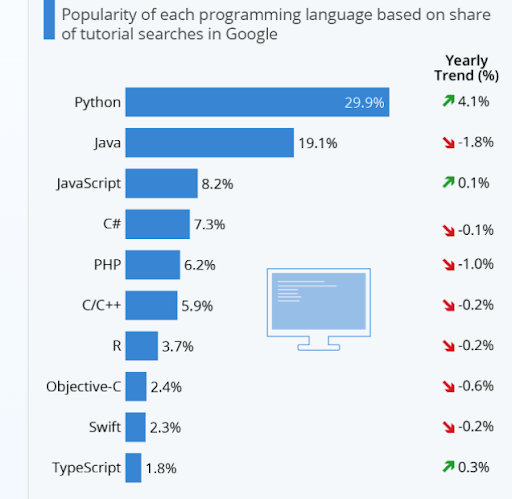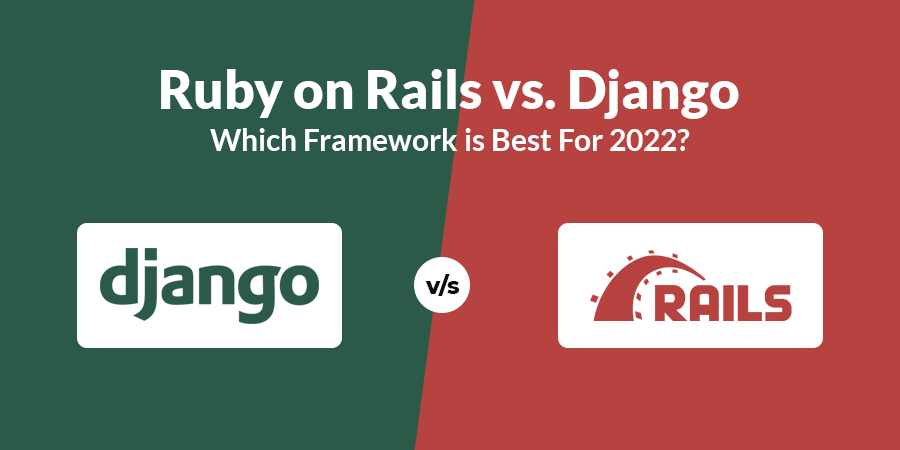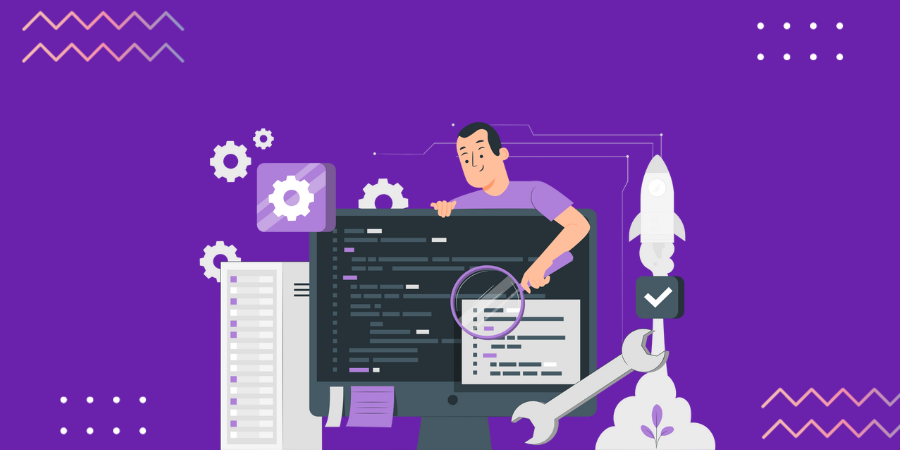In the world of programming, you’ll find a number of web development frameworks available for developers. But Ruby on Rails and Django stands out the most. Because both are object-oriented and dynamically-typed and their performance, which is specific for each project. Both are the most popular web frameworks and this popularity will continue to rise up in the coming years as well.
There is always a battle between Ruby on Rails vs Django, as many developers often compare these two frameworks to determine which one is the best for their web application. This is because out of all the web development frameworks, Ruby on Rails and Django web development framework are the two most popular and best choices.
It becomes critical to understand which framework is better for your next development project as both have gained a great deal of popularity and appreciation in the development world. However, though they have many common aspects in the programming phase, they still stand against each other very differently.
So if you are in the process of building a new website with the cherry-picked yet highly demanding framework, then it’s quite challenging for you to pick one over another. Because both are pretty good in their own way. Both have revolutionized the web development landscape and are used by prominent web development companies.
To give you an ease, we came up with a list of differences between them that could help you to make a decision. But first we should know what these two frameworks are and what are their advantages, and what makes Ruby on Rails and Django different? So, let’s take a quick look at that.
Overview of Ruby On Rails (ROR)
ROR is open-source software that is used to build web applications. Rail is a framework used to build websites using Ruby’s general-purpose programming language. If we talk about the rank, then Rub levels amongst the top ten programming languages are predominantly due to the roguishness of Rails.
David Heinemeier Hansson has built Ruby on Rails which is often called Rails. It integrates Ruby with HTML, CSS, and JavaScript to manufacture a web application that operates on a web server. Generally, it is considered to be a server-side web application platform.
However, Rails catalyzes the process of developing complex websites. John Dillon, CEO of Engine Yard, said Ruby’s productivity in Rails is anywhere from 2 to 2.5 times greater than a comparable Java programmer.
Ruby on Rails Architecture
Rails are designed on MVC (Model View Controller) architecture, a software design pattern for building web applications. It is made up of three parts such as:
1. Model
It is the lowest level of the pattern responsible for maintaining data.
2. View
The view is accountable for showing a portion of or all data to the viewer.
3. Controller
It is a software code that regulates interactions between Model and View.
Model view controller detaches the application logic from the user interface layer and assists concerns. The controller is the center that receives the application request and performs along with the model to deliver the required results, which are then in turn displayed by the view.
Overview of Django
Django is a free and open-source web application framework written in Python programming language. Django is a high-level framework that enables fast development and clean, pragmatic design. Created by experienced developers, Django takes care of much of the hassle of web development, so you can focus on writing your application without needing to reinvent the wheel.
Django offers a huge collection of modules for developers to use in their projects. By using Django, developers can save a lot of time and headaches. Basically, Django was created with front-end developers in mind.
Django’s template languages are designed to feel comfortable and easy to learn to those familiar with HTML, like designers and front-end developers. Still, it is flexible and highly extensible and allows developers to augment the template language as needed.
Django Architecture
Django architecture is based on MVT (Model-View-Template), a software design pattern for developing a web application. MVT structure has three parts such as:
1. Model
The model acts as the interface of your data and is responsible for maintaining data. It is the logical data structure behind the entire web application and is represented by a database.
2. View
The View is the user interface which means what you see in your browser when you render a website. It is represented by JavaScript/HTML/CSS and Jinja files.
3. Template
Template consists of static parts of the desired HTML output and some special syntax describing how dynamic your content will be inserted.
A Roundup of Top Companies Using Ruby on Rails
Several renowned companies are using Ruby on Rails owing to its pioneering traits such as flawless migration, database table formations, and scaffolding of views to facilitate the rapid development of web applications. ROR spans the financial sector, startups, fintech companies, startups, and businesses of all scales. Let’s take a look at some of the most famous enterprises using Ruby on Rails for web development.
- GitHub
- Etsy
- Shopify
- Zendesk
- Airbnb
- SlideShare
- Basecamp
- CrunchBase
A Roundup of Top Companies Using Django
Django is one of the most loved Python-based web frameworks that gives developers the tools they need for rapid and hassle-free development. You can find various significant companies employing Django for their development projects. See the list of global companies using Django:
- National Geographic
- Mozilla
- Spotify
- Disqus
- Bitbucket
- Eventbrite
- Prezi
What Do Ruby On Rails & Django Have in Common?
It is a fact that Ruby on Rails and Django have a lot of things in common, but each of them is born in a different ecosystem.
1. Languages
As discussed earlier, Django and Ruby on rails are object-oriented and dynamically typed languages; they are entirely different from the language used in enterprise ecosystems such as Java.
But there is one main difference, Python and Ruby are free and open-source, and their respective communities are very robust and productive. This means you don’t have to struggle to find the answer or documentation if you commit to using these frameworks.
2. Performance
Ruby and Django almost have the same level of performance- the difference is not noticeable for a typical CRUD (Create, read, update and delete) application. The difference is just as insignificant for large applications. If high performance is your priority and you need to serve thousands of users, neither is the right choice.
For clear understanding, let’s discuss this differently. Both are good at CPU expensive operations such as image manipulation, and they can also serve thousands of users. Still, it takes more effort to configure RUBY and Django for such a volume.
What Makes Ruby on Rails & Django Different?
1. Language
Ruby on Rails is based on the Ruby programming language. Whereas Django works with Python development which is one of the best programming languages and helps developers to build complex web applications. Ruby and Python are both robust, object-oriented, dynamically typed programming languages.
But if we compare, Python is a more general-purpose language used for developing games, Data Analytics, Machine learning algorithms, and AI (Artificial Intelligence) features. On the other hand, Ruby is used mainly for web development, providing web services as web APIs and web servers.
Python is one of the most readable programming languages with a smooth learning curve generally known for its portability, simplicity, readability, and versatility. Ruby is known for high productivity, fast development, and flexibility for web developers.
2. Architecture
Both Django and rails framework follow an indistinguishable architectural pattern. Ruby on Rails is dependent on MVC (Model View Controller) architecture, while Django follows the MVT (Model View Template) design pattern.
MVC and MVt are almost similar in implementations, but developers have to code all the control specific functions for the controller on rails in Ruby. But this is not with Django, as Django itself automatically takes care of the controller.
The developer codes the Model, the view, and the Templates, and Django takes care of the interactions between these layers and provides a render web page to users. The template is an HTML file associated with DTL (Django template language), which informs Django how the elements interact with each other.
3. Stability
ROR has a perfect balance between stability and flexibility as it allows users to reuse the code to abolish dependencies and at the same time implement new and innovative features. It also uses the convention over configuration technique, providing ease to coders from further efforts.
It gives the base to reduce the workload on Rails developers, but it also keeps it easily manipulated and customizable. But if we talk about the Django web development framework, it goes out of its way to prevent new implementations. This can seriously affect the flexibility and creativity of web developers.
4. Performance & Speed
Speed is the issue with both the web development frameworks. But if compared, then ROR is a little faster than the Django framework. According to the performance of both frameworks, Rails is found to be 0.7% faster.
It is due to the benefit of a rich repository of awesome plugins and libraries that boost the performance and speed of the framework.
Django is a Python-based framework that is a comparatively slow-performing language. Python’s interpreted and dynamic typing nature is carried forward to Django, which makes Django development slow. Also, Django has multiple inbuilt libraries and tools that further affect the framework’s speed.
5. Ecosystems
Whatever integration library you need, chances are you will find it for both Ruby on Rails and Django. However, Python is widely used for many purposes, not only for web app development but also for science and machine learning computations.
Whereas Ruby was designed to be a general-purpose solution, most of the live applications in Ruby are web applications such as Github.
6. Popularity
Both frameworks are popular and have made their mark in the industry in terms of popularity. But ROR has a more active community that continuously develops development solutions in Ruby GEM. But when it comes to popularity, Django is on top due to the popularity of the Python language.
It is one of the most renowned programming languages, and its popularity is growing faster than ever. The graph below shows you the growing popularity of Python.

Image Source:- https://www.statista.com/
7. Philosophies
Django relies on a DRY principle which means ‘Don’t Repeat Yourself. Repetition might be good to emphasize a point, but it leads to an additional and time-consuming task when it comes to web development. Django has eliminated the duplication while implementing the DRY concept.
Ruby on Rails is based on the motto “Convention over configuration”. You have to create less code in Rails to get the desired results because you skip the configuration part, which is essential in Django.
Final Words
Who Won The Battle – Ruby on Rails Vs. Django
Ruby on Rails and Django are both main full-stack competitors in web development. But there is a battle between these two frameworks, and people always tend to search Ruby on Rails vs. Django- which one is the best. However, both have their own capabilities, features, and popularity, yet choosing the one for development can be tricky. This is why it is suggested to have a clear business objective mind and know your project requirement to make the right decision. But for an experienced piece of advice, choosing a professional web development company can be the right choice you can make.
Although the above discussion will help you choose the best for your requirement, a doubting mind can create a mess. So it is good to go with professional brains to get reliable assistance. With the help of professionals, you can make the right decision that goes well with your business. Nascenture is the leading name when it comes to professional service provided as they have certified developers that help you in any manner. So if you have any queries or doubts, we are here to help you.





